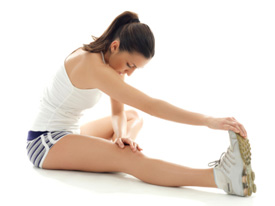Many people stretch before exercise to prevent injuries and reduce soreness the next day. For most of us it is hard enough to find time to exercise, let alone fit in a stretching session beforehand. So how important is it to stretch before getting active?
New studies provide some answers. Professor Rob Herbert, principal research fellow with Neuroscience Research Australia, says, “Some people think there’s just something intrinsically good about being flexible … I think that’s in the eye of the beholder. If you feel a bit more flexibility is helpful, that’s fine, but I don’t think from a health or physiological point of view that there’s any clear intrinsic benefit from being flexible.”
If you’re aiming to avoid sore muscles and injuries, there seems to be little if any gain from stretching. Regular stretching, however, might make you more flexible, which could help performance in certain sports but can hinder it in others.
Prof Herbert was involved in three large studies of more than 1000 subjects into stretching’s effects on exercise, and found little or no reduction in injury risk from exercise among those who rigorously stretched.
The largest of the three studies was performed in Norway where the common wisdom was always to stretch after exercise which differed from Australia, where most advice said to do it before. The study looked at the combined effect of stretching both before and after.
The study with Norwegians showed only a very slight reduction in how sore people perceived their muscles were from the exercise, half a point on a 10-point pain intensity scale. The benefit of reduced injury was also negligible. This stretching was for more than 14 minutes per exercise session. “It’s quite a lot of effort to make a small difference to a problem that’s not a big problem,” says Prof Herbert.
Soreness that begins 12-24 hours after exercise is known as ‘delayed onset muscle soreness’ (DOMS) with the most intense pain at 24-72 hours after exercise. This is essentially muscle damage, an effect of the repair process that develops in response to microscopic muscle damage caused by the exercise. This should not be interpreted as a bad thing, it’s a normal part of how muscles respond to intense activity and it’s probably associated with all sorts of positive adaptations, Prof Herbert says.

Is stretching a waste of time?
“Performed regularly, it’s possible, though not proven, that stretching may induce growth of tissues that leads to a more long-term increase in flexibility. This is likely to be helpful in certain sports like gymnastics, ballet, hurdles or high jumping.”
“For sports requiring big muscle forces and lots of power, such as sprinting or power lifting, there’s a belief among sports scientists that any extra flexibility from stretching might actually decrease performance.”
Regular chiropractic care has been shown to reduce the chance of injury, the severity of the injury and when injured increases the speed of recovery.

Jan 15, 2015 at 9:06 PM
The most noticeable thing about the comparison between Norwegian and Austrailian studys is the climate. Norway is cold therefore a thourough warm up is required before stretching should be attempted whereas Aus is warm and no warm up is required because the muscles will be warm from the climate. The most important issue here is to NOT stretch cold muscles. Also omitted is any recovery. Passive recovery (sitting on the sofa) will not aid recovery as quickly as active recovery. Active recovery is the slow and gentle use of muscles to flush out old repair nutirient by products and to replace them with new fresh repair nutrients, allowing the repair process to be completed before the next work out.
Jan 15, 2015 at 10:15 PM
Thanks for your comments Mark, it is always good to hear from those with a lot of personal experience.